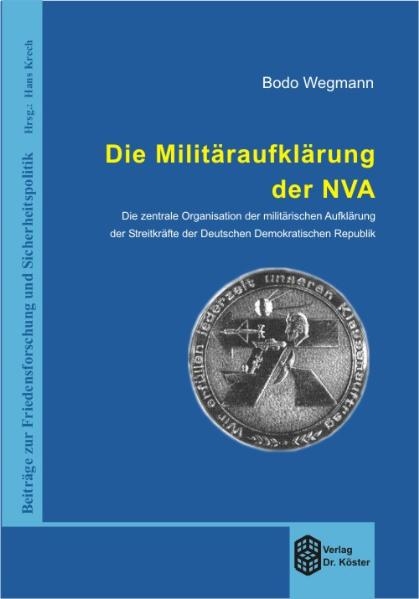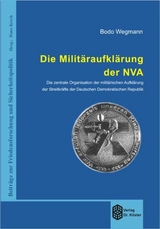Die Militäraufklärung der NVA
Verlag Dr. Köster
978-3-89574-580-5 (ISBN)
(ARD-Tagesthemen 1992)
Der Politikwissenschaftler Bodo Wegmann gewährt faszinierende und detaillierte Einblicke in diesen angeblichen „Supergeheimdienst“. Mehr als 60 Abbildungen dokumentieren die Entwicklung der militärischen Aufklärungsorganisation der DDR, die vor allem als Verwaltung Aufklärung bekannt wurde. Der ihr von der politischen und militärischen Führung zugewiesene Aufgabenrahmen wird ebenso rekonstruiert wie die eingesetzten Mittel und Methoden. Sie reichten von Agenten und Hilfsnetzelementen, über Illegale, Legalisten und Militärattachés bis zur technischen und Satellitenaufklärung. Leitende Offiziere des Zentrums in Ost-Berlin und geheime Quellen im westlichen Operationsgebiet werden porträtiert. Der Leser erfährt vieles über die Kooperation auf internationaler Ebene (bes. im Warschauer Vertrag) und das Verhältnis der NVA-Aufklärung zu Diensteinheiten der Staatssicherheit. Ein besonderes Kapitel schildert Kenntnisse und Maßnahmen gegnerischer Geheimdienste.
Die Arbeit basiert auf umfangreichen Quellen aus öffentlichen Archiven und nicht-öffentlichen Sammlungen, von nationalen und ausländischen Behörden sowie Nachrichtendiensten. Vieles wurde erstmals freigegeben. Darüber hinaus standen dem Autor mehr als 80 Zeitzeugen und Kenntnisträger aus Ost und West zur Verfügung. Aufgrund der Quellenvielfalt und präzisen Darstellungen bezeichnen die Gutachten diese Dissertation, die weniger zum Lesen als zum Nachlesen geeignet ist, als „histoire totale“ und „umfassende Enzyklopädie des militärischen Nachrichtendienstes der DDR“.
English: Besides the Ministry of State Security (MSS) the German Democratic Republic had further governmental secret intelligence services which have been widely unnoticed so far. One of them was the central organization for military reconnaissance of the East-German armed forces. On the one hand it had been a typical intelligence service (conducting human intelligence) while on the other hand being responsible for co-ordinating the military recon-naissance of all army levels including signals intelligence. This organization was established in 1952. Under varying names it was in existence until 1990. In the West it became known as „Verwaltung Aufklaerung“ (reconn. department, VA) and „Bereich Aufklaerung“ (reconn. sector, BA). This study documents origins, the formation and development of this organization and its functional elements. It outlines the tasks assig-ned by the political and military leadership as well as the techniques and methods it had applied. It includes portraits of leading officers of the Centre and secret assets in Western nations. The co-operation of the reconnais-sance of the East-German National People’s Army (NPA) on the international scale within the Warsaw Pact, the military intelligence and reconnaissance services of its armies and with further nations are described as well as rela-tions to units of the MSS and special forces of the NPA. One chapter concentrates on the perception of this apparatus by security and intelligence authorities of those countries in the West against which the organization had operated, especially NATO nations. While the VA/BA brought more than 100 secret assets into action moles and defectors revealed internal information. Until 1990 they had been the most important sources of knowledge regarding this organization. Finally the thesis reconstructs the last months of the Information-Centre (as the service had been renamed in the final period of the GDR) when secret operations in the West were ceased and files and records destroyed. At the time plans were introduced as to the continuance of the organization as part of the CSCE or within the armed forces of a united Germany. The study contains an extensive list of abbreviations and termini the NPA’s recon-naissance service had used. More than 60 illustrations detail structural developments and reproduce some orginal documents. Manifold primary sources from public archives and non-public collections as well as from national and foreign authorities and intelligence services are the basis of this thesis. Many of these documents have been released for it for the first time. In addition more than 80 contempo-rary witnesses and experts allowed to be interviewed. Applying Oral History methods their statements could be processed into important sources, too. Because of the variety of sources and their continously precise processing the experts’ reports have judged this thesis as a “histoire totale“ and a “comprehensive encyclopedia of the military intelligence service of the GDR”.
| Erscheint lt. Verlag | 30.3.2006 |
|---|---|
| Reihe/Serie | Beiträge zur Friedensforschung und Sicherheitspolitik |
| Verlagsort | Berlin |
| Sprache | deutsch |
| Maße | 148 x 210 mm |
| Gewicht | 932 g |
| Einbandart | Paperback |
| Themenwelt | Sachbuch/Ratgeber ► Geschichte / Politik ► Zeitgeschichte ab 1945 |
| Geisteswissenschaften ► Geschichte | |
| Sozialwissenschaften ► Politik / Verwaltung ► Staat / Verwaltung | |
| Schlagworte | Aufklärung (Militär) • DDR • Geheimdienst • Hardcover, Softcover / Sachbücher/Geschichte/Zeitgeschichte (1945 bis 1989) • Militärische Aufklärung • Nationale Volksarmee der DDR (NVA) • NVA |
| ISBN-10 | 3-89574-580-4 / 3895745804 |
| ISBN-13 | 978-3-89574-580-5 / 9783895745805 |
| Zustand | Neuware |
| Haben Sie eine Frage zum Produkt? |
aus dem Bereich




